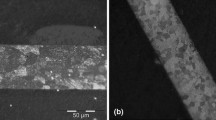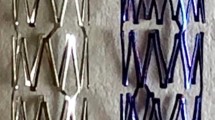Abstract
In this paper, we report an evaluation of the performance of a new stent durability tester based on the electrical potential sensing method through accelerated in vitro testing of six different nonvascular Nitinol stents simulating physiological conditions. The stents were subjected to a pulsatile loading of 33 Hz for a total of 62,726,400 cycles, at constant temperature and pressure of 35±0.5 °C and 120±4 mmHg, respectively. The electrical potential of each stent was measured in real-time and monitored for any changes in readings. After conducting test-to-fracture tests, the stents were visually checked, and by scanning electron microscopy. A sudden electrical potential drop in the readings suggests a fracture has occurred, and the only two instances of fracture in our present results were correctly determined by our present device, with the fractures confirmed visually after the test. The excellent performance of our new method shows good potential for a highly reliable and applicable in vitro durability testing for different kinds and sizes of metallic stents.






Similar content being viewed by others
References
B.A. James, R.A. Sire, Fatigue-life assessment and validation techniques for metallic vascular implants. Biomaterials 31(2), 181–186 (2010)
X. Zhou, Z. You, J. Byrne, Bio-inspired leaf stent for direct treatment of cerebral aneurysms: design and finite element analysis. Smart Struct. Syst. 8(1), 1–15 (2011)
D.K. Lee, Drug-eluting stent in malignant biliary obstruction. J. Hepatobiliary Pancreat. Surg. 16(5), 628–632 (2009)
C. Dumoulin, B. Cochelin, Mechanical behaviour modelling of balloon-expandable stents. J. Biomech. 33(11), 1461–1470 (2000)
J.J. Li, Q.Y. Luo, Z.Y. Xie, Y. Li, Y.J. Zeng, Fatigue life analysis and experimental verification of coronary stent. Heart Vessels 25(4), 333–337 (2010)
C. Capelli, F. Gervaso, L. Petrini, G. Dubini, F. Migliavacca, Assessment of tissue prolapse after balloon-expandable stenting: influence of stent cell geometry. Med. Eng. Phys. 31(4), 441–447 (2009)
N. Muhammad, L. Li, Underwater femtosecond laser micromachining of thin nitinol tubes for medical coronary stent manufacture. Appl. Phys. A, Mater. Sci. Process. 107(4), 849–861 (2012)
S.W. Robertson, R.O. Ritchie, A fracture-mechanics-based approach to fracture control in biomedical devices manufactured from superelastic nitinol tube. J. Biomed. Mater. Res., Part B, Appl. Biomater. 84B(1), 26–33 (2008)
S.W. Robertson, R.O. Ritchie, In vitro fatigue-crack growth and fracture toughness behavior of thin-walled superelastic nitinol tube for endovascular stents: a basis for defining the effect of crack-like defects. Biomaterials 28(4), 700–709 (2007)
US Food and Drug Administration, Non-clinical tests and recommended labeling for intravascular stents and associated delivery systems: guidance for industry and FDA staff. US Department of Health and Human Services, Food and Drug Administration, Center for Devices and Radiological Health January 13, 2005
G. Riepe, C. Heintz, E. Kaiser, N. Chakfe, M. Morlock, M. Delling, H. Imig, What can we learn from explanted endovascular devices? Eur. J. Vasc. Endovasc. Surg. 24(2), 117–122 (2002)
T.S. Jacobs, J. Won, E.C. Gravereaux, P.L. Faries, N. Morrissey, V.J. Teodorescu, L.H. Hollier, M.L. Marin, Mechanical failure of prosthetic human implants: a 10-year experience with aortic stent graft devices. J. Vasc. Surg. 37(1), 16–26 (2003)
S.N.D. Chua, B.J. Mac Donald, M.S.J. Hashmi, Finite element simulation of stent and balloon interaction. J. Mater. Process. Technol. 143, 591–597 (2003)
C.H. Park, L.D. Tijing, Y. Yun, C.S. Kim, A novel electrical potential sensing method for in vitro stent fracture monitoring and detection. Bio-Med. Mater. Eng. 21(4), 213–222 (2011)
F.G. Kline, F.A. McClintock, Describing uncertainties in single sample experiments. Mech. Eng. 75, 3–8 (1953)
A.R. Pelton, V. Schroeder, M.R. Mitchell, X.Y. Gong, M. Barney, S.W. Robertson, Fatigue and durability of nitinol stents. J. Mech. Behav. Biomed. Mater. 1(2), 153–164 (2008)
M. Gottsauner-Wolf, D.J. Moliterno, A.M. Lincoff, E.J. Topol, Restenosis—an open file. Cardiol. Clin. 19, 347–356 (1997)
M.C. Morice, P.W. Serruys, J.E. Sousa, J. Fajadet, E.B. Hayashi, M. Perin, A. Colombo, G. Schuler, P. Barragan, G. Guagliumi, F. Molnar, R. Falotico, A ramdomized comparison of a sirolimus-eluting stent with a standard stent for coronary revascularization. N. Engl. J. Med. 346, 1773–1780 (2000)
R. Guidoin, Y. Marois, Y. Douville, M.W. King, M. Castonguay, A. Traore, M. Formichi, L.E. Staxrud, L. Norgren, P. Bergeron, J.P. Becquemin, J.M. Egana, P.L. Harris, First-generation aortic endografts: analysis of explanted stenter devices from the EUROSTAR registry. J. Endovasc. Ther. 7(2), 105–122 (2000)
H.J. Salacinski, S. Goldner, A. Giudiceandrea, G. Hamilton, A.M. Seifalian, A. Edwards, R.J. Carson, The mechanical behavior of vascular grafts: a review. J. Biomater. Appl. 15(3), 241–278 (2001)
R. Uflacker, J. Robison, Endovascular treatment of abdominal aortic aneurysms: a review. Eur. Radiol. 11(5), 739–753 (2001)
X.Y. Gong, D.J. Chwirut, M.R. Mitchell, B.D. Choules, Fatigue to fracture: an informative, fast, and reliable approach for assessing medical implant durability. J. ASTM Int. 6(7), 1–10 (2009)
R. Guidoin, Y. Douville, M.W. King, M. Castonguay, A. Traore, M. Formichi, L.E. Staxrud, L. Norgren, P. Bergeron, J.P. Becquemin, J.M. Egana, P.L. Harris, First-generation aortic endografts: analysis of explanted stentor devices from the EUROSTAR registry. J. Endovasc. Ther. 7(2), 105–122 (2000)
S. Schievano, A.M. Taylor, C. Capelli, P. Lurz, J. Nordmeyer, F. Migliavacca, P. Bonhoeffer, Patient specific finite element analysis results in more accurate prediction of stent fractures: application to percutaneous pulmonary valve implantation. J. Biomech. 43(4), 687–693 (2010)
R.V. Marrey, R. Burgermeister, R.B. Grishaber, R.O. Ritchie, Fatigue and life prediction for cobalt-chromium stents: a fracture mechanics analysis. Biomaterials 27(9), 1988–2000 (2006)
E. Black, R. Burgermeister, R.D.B. Grishaber, D.W. Overaker, Systems and methods for fatigue testing systems. U.S. Patent 7,363,821 B2, 2008
H. Zhao, L. Wang, Y. Li, X. Liu, A new device to study fatigue performance and mathematical model to analyze relationship between textile parameters and fatigue of textile scaffold for stent-graft, in Proc. of the 3rd International Conference on Bioinformatics and Biomedical Engineering: ICBBE, Beijing, China (2009), pp. 1–6
A. Nikanorov, H.B. Smouse, K. Osman, M. Bialas, S. Shrivastava, L.B. Schwartz, Fracture of self-expanding nitinol stents stressed in vitro under simulated intravascular conditions. J. Vasc. Surg. 48(2), 435–440 (2008)
K.S. Vilendrer, Direct strain measurement method using an endoscope, EnduraTECH Systems Corporation. Retrieved October 25, 2010 from http://www.bose-electroforce.com/papers/ID-OD.pdf
S. Muller-Hulsbeck, P.J. Schafer, N. Charalambous, H. Yagi, M. Heller, T. Jahnke, Comparison of second-generation stents for application in the superficial femoral artery: an in vitro evaluation focusing on stent design. J. Endovasc. Ther. 17(6), 767–776 (2010)
R.S. Perret, G.D. Sloop, J.A. Borne, Common bile duct measurements in an elderly population. J. Ultrasound Med. 19(11), 727–730 (2000)
European Standard EN12006-3: 1998, Non active surgical implants—particular requirements for cardiac and vascular implants—part 3: endovascular devices
Acknowledgements
This research was supported by a grant from the Ministry of Education, Science, and Technology through the Leaders in Industry-University Cooperation (LinC) Project (Project no. 2012-C-0043-010111) and also by a grant from the Business for Greening the Manufacturing Environment Technology Development Project funded by the Korean Small and Medium Business Administration (Project no. S2025435).
Author information
Authors and Affiliations
Corresponding authors
Rights and permissions
About this article
Cite this article
Park, CH., Tijing, L.D., Pant, H.R. et al. Accelerated in vitro durability testing of nonvascular Nitinol stents based on the electrical potential sensing method. Appl. Phys. A 112, 919–926 (2013). https://doi.org/10.1007/s00339-012-7447-8
Received:
Accepted:
Published:
Issue Date:
DOI: https://doi.org/10.1007/s00339-012-7447-8




